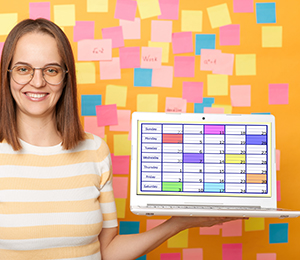PART 1 of our Effective Online Learners series:
An Effective Learning Environment,
Goal Setting, and Scheduling
 PART 1:
PART 1:An Effective Learning Environment,
Goal Setting,
and Scheduling
by Gordon Gower
As a SchoolsPLP Senior Training & Support Lead, Gordon Gower brings over 20 years of experience in teaching at Title I middle schools and training educators on how to effectively implement online learning strategies. Here Gordon shares insights for students about creating an effective learning space, goal setting & understanding SchoolsPLP course schedules and pace dates.
Effective Students:
- 1. Create an effective learning space with an appropriate device
- 2. Set goals and understand schedules and pace dates

Highly successful students aren’t made overnight! Having a personalized learning environment that is tailored to a student’s strengths enables them to successfully work remotely or at school. High performing students are also in the habit of setting appropriate goals using the information they have available.
Creating a personalized learning space for remote learning can significantly enhance a student's focus, productivity, and overall learning experience.
Here are some practical steps to help you craft an effective and personalized learning environment:
 1. Choose the Right Location
1. Choose the Right Location• Identify a quiet and well-lit area to learn. Natural light is ideal for reducing eye strain and boosting mood.
• Consider a space with minimal distractions to help maintain focus.
• If you have limited control over your environment, try using headphones or playing white noise to minimize distractions.
 2. Get Comfortable and Personalize Your Space
2. Get Comfortable and Personalize Your Space• If possible, invest in a comfortable chair and desk. To avoid discomfort during long study sessions, your seating should encourage good posture.
• Decorate your area with items that provide comfort and motivate you. This could include plants, pillows, posters, artwork, or quotes that resonate with your goals.
• Keep your space tidy and organized to create a conducive learning environment.
 3. Set Up Dedicated Study Technology
3. Set Up Dedicated Study Technology• Ensure you have an appropriate device with an up-to-date browser and a stable internet connection to access your online coursework.
• Organize cables and technology tools to keep everything easily accessible.
 4. Create a Study Schedule and Limit Distractions
4. Create a Study Schedule and Limit Distractions• Establishing a consistent study routine can help your brain recognize when it's time to focus and when it's time to relax.
• Disable unnecessary device notifications when studying.
• Consider using productivity tools or apps that block distracting websites or notifications during your study time. A student at the University of Waterloo in Ontario, Canada, compiled this list of free or almost free productivity apps to help students focus!
 5. Keep Resources within Reach
5. Keep Resources within Reach• If applicable, have textbooks, notebooks, highlighters, and any other study materials within reach to minimize disruptions.
 6. Collaborate
6. Collaborate
• Join virtual study sessions or check with school staff about
on-site study opportunities.
• Virtual students can sometimes feel isolated so collaborating or joining on-site study sessions can be a jumpstart to their motivation.
 7. Regularly Evaluate and Adjust
7. Regularly Evaluate and Adjust• Periodically assess your learning space to see what's working and what needs adjustment. Your needs and preferences may evolve over time.

Successful students also know how to create and manage appropriate progress goals. When a student is enrolled in a course inside SchoolsPLP, the program automatically generates suggested pace dates for each activity, or it will display due dates that have been specified by the instructor.

It is also important to note that suggested pace dates inside SchoolsPLP allot more time for activities that hold a greater grade weight to make sure there’s adequate time to complete the task. For example, students may be given multiple days to study for a larger assessment or writing activity. To stay on pace, students should review their grades tab daily to see which activities should be submitted.
Dr. Scott Dako states in his research entitled, Time of Submission: An indicator of procrastination and a correlate of performance on undergraduate marketing assignments, “Students who hand in their assignments at the last-minute face a roughly 5% decrease in overall scores.” This research reminds us that goal setting to complete activities before their pace dates have passed is a good habit to form.
Another tool students can use to set goals inside SchoolsPLP is their auto-generated Pulse Report (message). Students receive this report every Monday morning to inform them of their progress from the week before and what is expected for the upcoming week.
Students are also able to view their current activity and pacing updates in the weekly Pulse report. As mentioned before, students can plan their week by monitoring this information.
With an appropriate self-selected learning environment, and the ability to manage and accomplish pacing and scheduling goals, students’ success rates inside SchoolsPLP will skyrocket!
- CONTACT
- Contact Us
- Check status of SchoolsPLP
- 24 W Camelback Road Suite A-422, Phoenix, AZ 85013
- 800-484-3061 Toll Free
- 602-277-9266 Fax
- hello@schoolsplp.com
- support@schoolsplp.com
- sales@schoolsplp.com
- instruction@schoolsplp.com
- PRODUCT
- Course Catalog
- Visit the SchoolsPLP Playground!
- Free Curriculum Preview!
- Go back to Explore!
- Follow us on:
- CONTACT
- Check status of SchoolsPLP
- 24 W Camelback Road Suite
A-422, Phoenix, AZ 85013 - 800-484-3061 Toll Free
- 602-277-9266 Fax
- hello@schoolsplp.com
- support@schoolsplp.com
- instruction@schoolsplp.com
- PRODUCT
- Course Catalog
- Privacy Policy
- Visit the SchoolsPLP Playground!
- Free Curriculum Preview!
- Go back to Explore!
- Follow us on:









